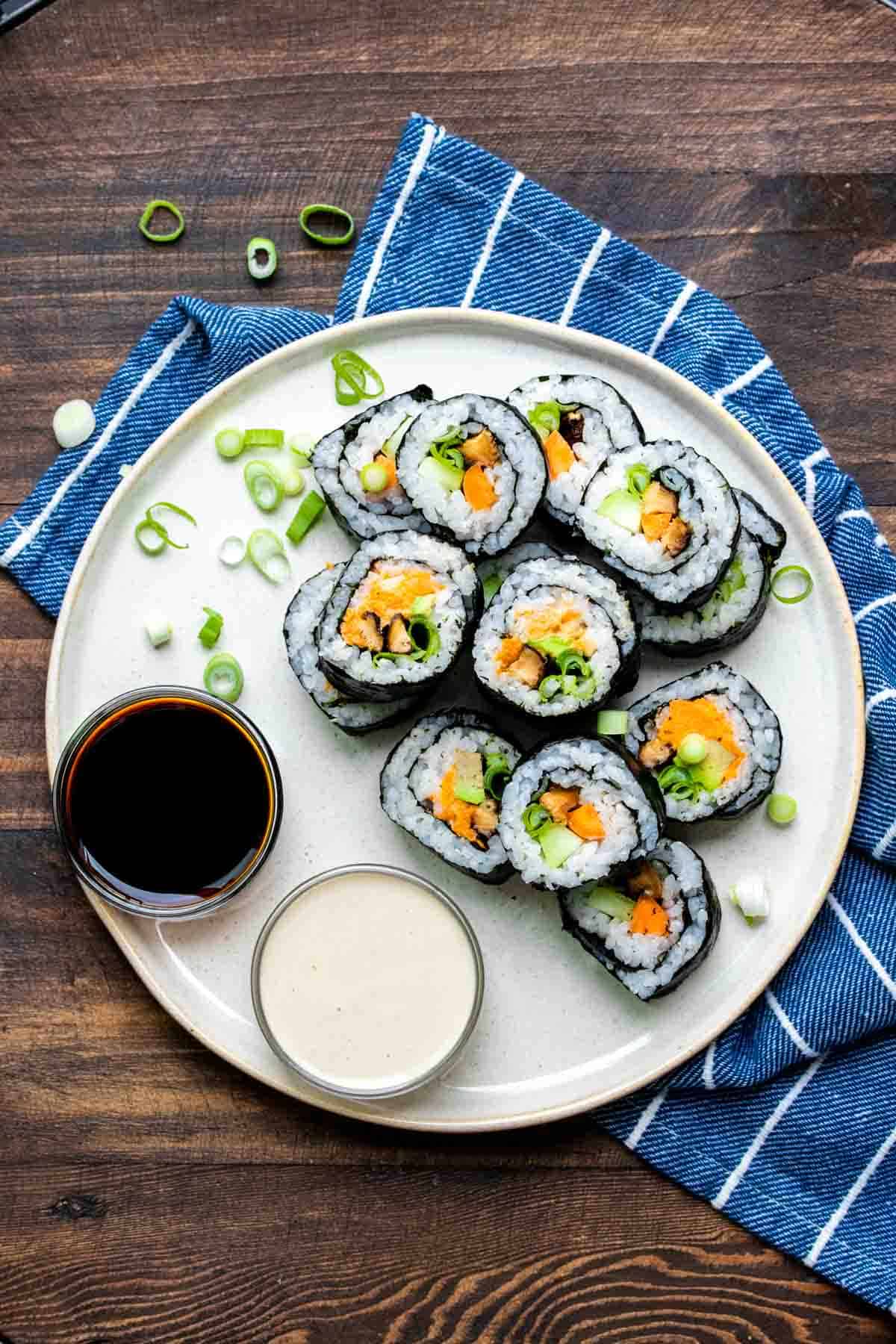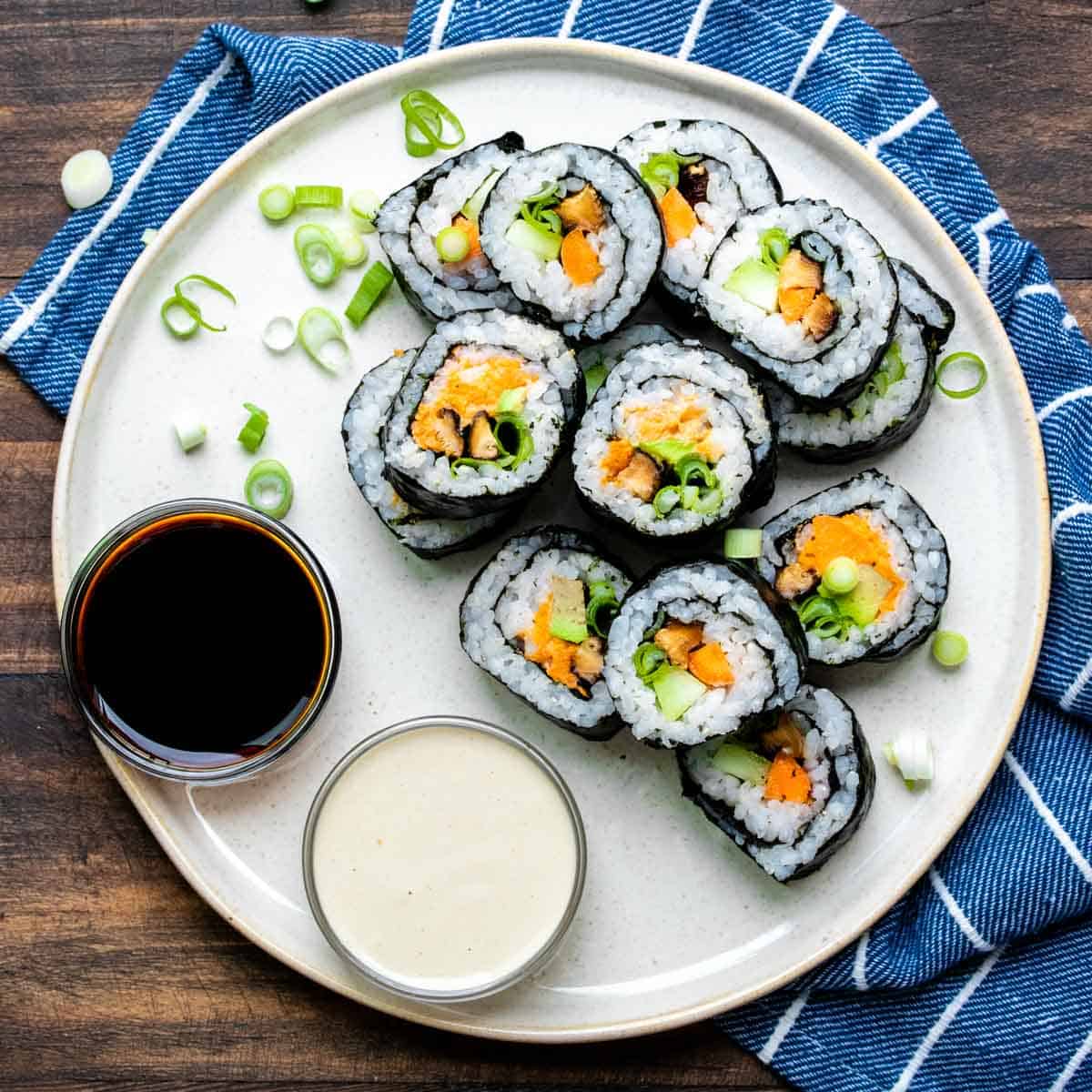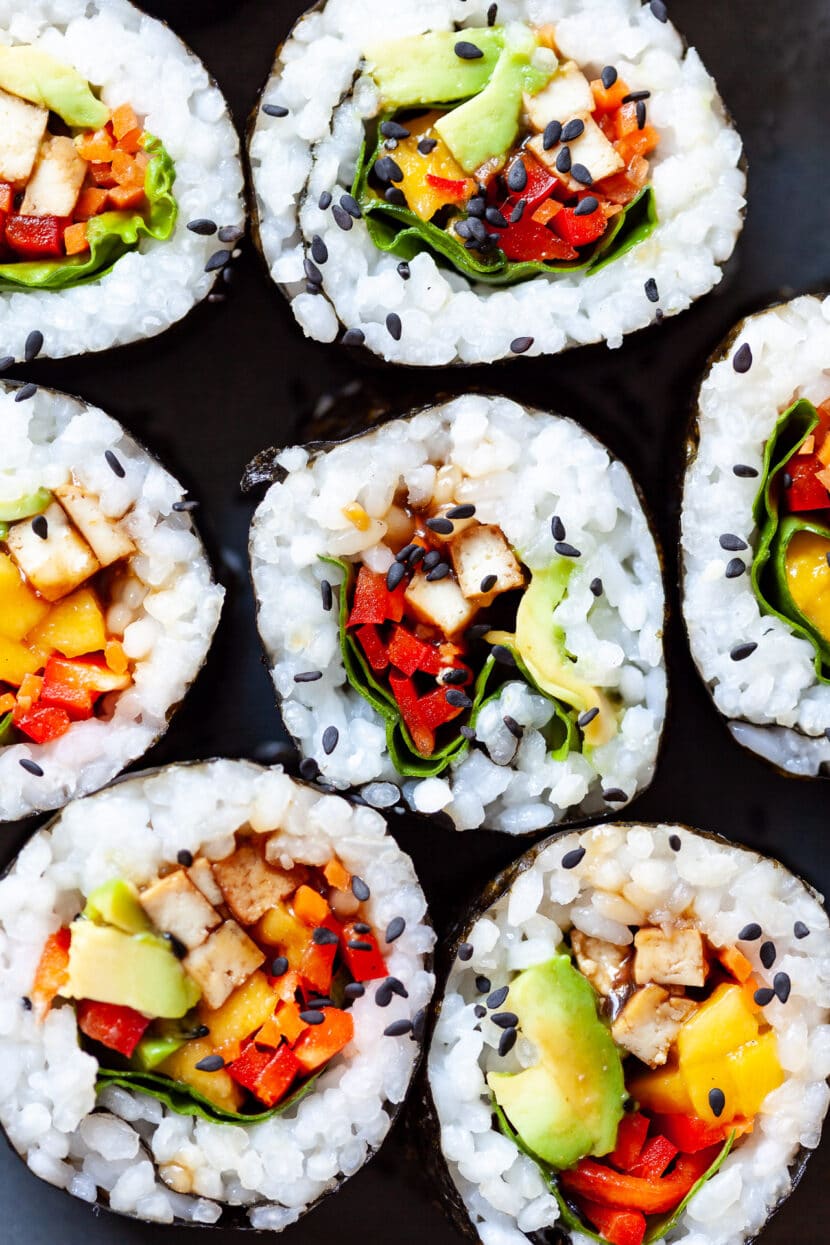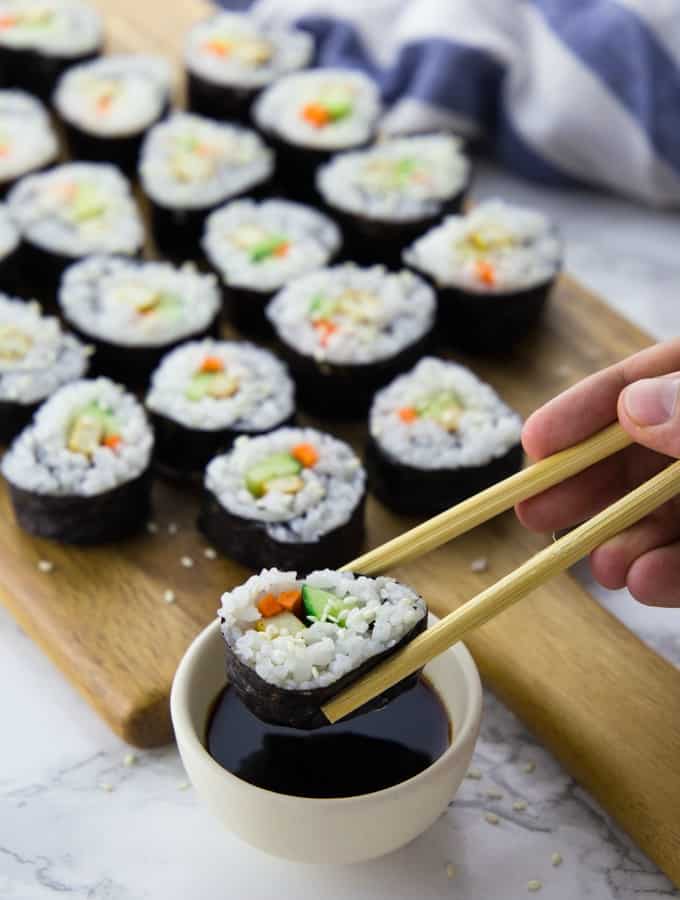Contents
- I. Introduction to Homemade Vegan Sushi
- II. Benefits of Making Vegan Sushi at Home
- III. Essential Ingredients for Homemade Vegan Sushi
- IV. Step-by-Step Guide to Making Homemade Vegan Sushi
- V. Tips and Tricks for Perfect Homemade Vegan Sushi
- VI. Frequently Asked Questions about Homemade Vegan Sushi
- 1. Can I use regular rice instead of sushi rice?
- 2. What vegetables work best in vegan sushi?
- 3. How do I prevent my nori sheets from getting soggy?
- 4. Can I substitute soy sauce with other condiments?
- 5. How do I roll sushi without a bamboo mat?
- 6. Can I prepare vegan sushi in advance?
- 7. Are there gluten-free options for vegan sushi?
- 8. How do I slice my sushi rolls neatly?
- 9. Can I freeze homemade vegan sushi?
- 10. How long can homemade vegan sushi be stored?
- VII. Conclusion
I. Introduction to Homemade Vegan Sushi

Are you a sushi lover but follow a vegan diet? No worries! You can still enjoy the delightful flavors of sushi by making your own homemade vegan sushi. This article will guide you through the process and provide helpful tips to ensure your sushi turns out deliciously satisfying.
Making vegan sushi is not only a great way to cater to dietary restrictions, but it also allows you to get creative with various plant-based ingredients. Whether you’re new to making sushi or an experienced chef, this recipe will be easy to follow and customize according to your taste preferences.
The Perfect Sushi Rice
The foundation of any good sushi roll is the rice. For vegan sushi, opt for short-grain Japanese rice as it provides the perfect sticky texture necessary for rolling. Rinse the rice thoroughly before cooking and use a ratio of one cup of rice with one and a half cups of water for fluffy yet sticky results.
Vegan Fillings and Flavor Combinations
When it comes to fillings, there are endless possibilities for creating tasty combinations in vegan sushi rolls. Some popular options include avocado, cucumber, carrot, bell peppers, tofu, mushrooms, and even fruit like mango or pineapple for added sweetness.
To add extra flavor and depth, consider marinating tofu or tempeh in soy sauce or tamari before adding them as fillings. You can also experiment with different sauces such as spicy mayo made from plant-based mayonnaise or tangy teriyaki sauce drizzled on top.
Sushi Rolling Techniques
Rolling your own homemade vegan sushi may seem intimidating at first glance; however, with practice and patience, anyone can master this skill. Start by placing nori seaweed sheets on a bamboo sushi mat, making sure to leave a small border at the top. Spread a layer of sushi rice evenly over the nori, leaving about an inch empty at the bottom.
Next, arrange your desired fillings in a line across the center of the rice. Using the bamboo mat, carefully roll up the sushi, applying gentle pressure to ensure it holds together. Wetting your hands slightly can prevent sticking and make rolling easier.
Serving and Enjoying Vegan Sushi
Once you’ve rolled your vegan sushi rolls successfully, all that’s left is to slice them into bite-sized pieces using a sharp knife. Serve with soy sauce or tamari for dipping and pickled ginger for added zestiness. You can also garnish with sesame seeds or scallions for extra flavor and presentation.
Enjoy your homemade vegan sushi as an appetizer or main dish alongside miso soup or a refreshing salad. It’s perfect for lunchboxes, parties, or simply indulging in a healthy yet delicious meal anytime!
II. Benefits of Making Vegan Sushi at Home

When it comes to sushi, many people think of raw fish rolled in seaweed and rice. However, vegan sushi has been gaining popularity for its delicious flavors and health benefits. Making vegan sushi at home not only allows you to customize the ingredients according to your preferences but also offers several other advantages.
1. Healthier Option
Making vegan sushi at home gives you full control over the ingredients used, ensuring a healthier meal. By choosing fresh vegetables, fruits, and plant-based proteins like tofu or tempeh as fillings, you can create a nutritious dish packed with vitamins, minerals, and fiber.
2. Cost-Effective
Going out for sushi can be quite expensive, especially if you have dietary restrictions or prefer specialty rolls. However, making vegan sushi at home is a cost-effective alternative that allows you to enjoy this delectable dish without breaking the bank.
3. Customizable Flavors
Vegan sushi offers endless possibilities when it comes to flavor combinations. You can experiment with different vegetables such as avocado, cucumber, carrots, bell peppers or add unique elements like mango or pickled radish for a burst of tanginess.
4. Creative Outlet
Making your own vegan sushi provides an opportunity to unleash your creativity in the kitchen! From experimenting with various fillings and toppings to creating aesthetically pleasing rolls with colorful ingredients – the possibilities are vast.
Tips:
- Add herbs like cilantro or basil for added freshness.
- Incorporate different textures by using crispy tempura flakes or creamy sauces.
- Try different types of rice like brown or black for added nutritional value.
5. Allergy-Friendly
Vegan sushi is an excellent option for individuals with food allergies or dietary restrictions. By avoiding common allergens such as fish, shellfish, and dairy, you can enjoy a delicious sushi experience without worrying about allergic reactions.
6. Environmentally Friendly
The production of vegan sushi has a lower impact on the environment compared to traditional fish-based sushi. By choosing plant-based ingredients, you contribute to reducing overfishing and promoting sustainable food choices.
III. Essential Ingredients for Homemade Vegan Sushi

When it comes to making delicious homemade vegan sushi, having the right ingredients is key. From the rice to the fillings and toppings, every component contributes to the overall flavor and texture of your sushi rolls. Here are some essential ingredients you’ll need:
1. Sushi Rice
The foundation of any good sushi roll is high-quality sushi rice. Look for short-grain Japanese rice that becomes sticky when cooked. Rinse the rice thoroughly before cooking to remove excess starch, and cook it according to package instructions.
2. Nori Sheets
Nori sheets are thin seaweed wrappers that hold all the ingredients together in a sushi roll. Choose roasted nori sheets for a slightly toasted flavor, which adds depth to your rolls.
3. Vegetables
Vegan sushi offers endless possibilities when it comes to vegetable fillings! Popular choices include cucumber, avocado, carrot sticks, bell peppers, and thinly sliced radishes or beets. Ensure that all vegetables are fresh and crisp for optimal taste.
4. Tofu or Tempeh
To add a protein element to your vegan sushi rolls, consider using marinated tofu or tempeh as one of your filling options. These plant-based proteins provide a satisfying texture alongside the other ingredients.
5. Condiments and Sauces
No sushi roll is complete without some delicious condiments and sauces! Include soy sauce or tamari for dipping along with pickled ginger and wasabi paste for an extra kick of flavor.
6. Sesame Seeds or Furikake
Add some crunch and flavor by sprinkling sesame seeds or furikake, a Japanese seasoning blend, over your sushi rolls. These toppings enhance the visual appeal and taste of the final dish.
7. Sushi Rolling Mat
A bamboo sushi rolling mat is essential for creating tightly rolled sushi. It helps maintain the shape and structure of your rolls while ensuring that all ingredients are evenly distributed.
8. Sharp Knife
To achieve clean and precise slices, use a sharp knife when cutting your sushi rolls into bite-sized pieces. This will prevent them from falling apart and give them an aesthetically pleasing appearance.
9. Patience and Practice
Making homemade vegan sushi may require some practice to perfect your rolling technique, but don’t get discouraged! With patience and practice, you’ll soon be making beautiful sushi rolls that rival those from your favorite restaurant.
IV. Step-by-Step Guide to Making Homemade Vegan Sushi

Making your own homemade vegan sushi can be a fun and rewarding experience. With a few simple ingredients and some basic techniques, you can create delicious rolls that are both healthy and satisfying. Here is a step-by-step guide to help you get started:
Gather the Ingredients
Before you begin, make sure you have all the necessary ingredients on hand. You will need sushi rice, nori sheets (seaweed), a variety of fresh vegetables like cucumber, avocado, and carrot, as well as soy sauce and wasabi for dipping.
Cook the Sushi Rice
Start by rinsing the sushi rice under cold water until it runs clear. Then, cook it according to the package instructions or using a rice cooker. Once cooked, let it cool for a few minutes before using.
Prepare the Vegetables
While the rice is cooling, prepare your vegetables by washing them thoroughly and cutting them into thin strips or julienne pieces. This will make it easier to roll them up inside the sushi.
Lay Out Nori Sheets
Place a sheet of nori on top of a bamboo rolling mat or clean kitchen towel. Make sure that shiny side faces down.
Add Rice and Vegetables
Scoop about half a cup of cooked rice onto one end of the nori sheet and spread it out evenly with wet fingers or with the back of a spoon, leaving about an inch at one end without any rice. Add your desired vegetables on top of the rice in horizontal lines.
Roll It Up
Tightly roll up everything using your bamboo mat or kitchen towel, applying gentle pressure to keep the roll intact. Wetting the empty end of the nori sheet will help seal it together.
Cut and Serve
Once your sushi roll is tightly wrapped, use a sharp knife to slice it into bite-sized pieces. Wipe the knife with a damp cloth between each cut for cleaner slices. Serve your homemade vegan sushi rolls with soy sauce and wasabi on the side.
Remember, making sushi takes practice, so don’t worry if your first attempts are not perfect. With time and experience, you will improve your rolling skills and create beautiful and delicious homemade vegan sushi.
V. Tips and Tricks for Perfect Homemade Vegan Sushi
Creating delicious vegan sushi at home can be a fun and rewarding experience. Whether you are a seasoned sushi enthusiast or just starting out, these tips and tricks will help you achieve perfect results every time.
1. Choose the Right Rice
The foundation of any good sushi is the rice. Opt for short-grain Japanese rice, as it has the perfect stickiness to hold your rolls together. Rinse the rice thoroughly before cooking to remove excess starch, which can make the grains too sticky.
2. Mastering Rice Seasoning
The seasoning of the rice is what gives sushi its distinct flavor. Prepare a mixture of rice vinegar, sugar, and salt to season your cooked rice while it’s still warm. Gently fold in this mixture using a wooden spatula to ensure even distribution without mashing up the grains.
3. Get Creative with Fillings
Vegan sushi offers endless possibilities when it comes to fillings. Experiment with different combinations such as avocado, cucumber, carrot sticks, marinated tofu or tempeh, pickled radish, or even mango slices for a burst of sweetness.
4. Perfectly Rolled Nori Sheets
To roll your sushi like a pro, make sure your nori sheets are placed shiny side down on top of a bamboo mat covered with plastic wrap or inside-outside baggie that allows smooth rolling without sticking excessively.
5.Choosing Your Rolling Technique
If you’re new to rolling sushi at home use traditional Maki rolls by placing ingredients in center then gently roll from bottom up over filling pressing tightly but gently For more advanced techniques try making Uramaki or inside-out rolls where the rice is on the outside and nori wraps around filling. Remember to wet your hands with water before handling the rice to prevent it from sticking.
6. The Art of Slicing
Once your sushi roll is complete, it’s time to slice it into bite-sized pieces. Use a sharp, damp knife for clean cuts without squishing the roll. Wiping off excess rice residue with a damp cloth between each cut will help create neat slices.
7. Dipping Sauces and Garnishes
Elevate your homemade vegan sushi experience by serving them with delicious dipping sauces and garnishes. Classic options include soy sauce, wasabi, pickled ginger, sriracha mayo or sesame seeds sprinkled on top for added texture and flavor.
By following these tips and tricks, you’ll be well on your way to creating perfect homemade vegan sushi that rivals any restaurant experience. So grab your ingredients, get rolling, and enjoy this delightful culinary adventure in the comfort of your own kitchen!
VI. Frequently Asked Questions about Homemade Vegan Sushi
In this section, we will address some common questions that people often have when it comes to making homemade vegan sushi. Whether you are a beginner or an experienced chef, these FAQs will provide you with valuable insights and tips for creating delicious plant-based sushi rolls.
1. Can I use regular rice instead of sushi rice?
While sushi rice is traditionally used for making sushi, you can definitely experiment with other types of rice. Just keep in mind that the stickiness and texture of sushi rice play a crucial role in holding the ingredients together. If using regular rice, make sure it’s slightly sticky to ensure your rolls don’t fall apart.
2. What vegetables work best in vegan sushi?
The beauty of vegan sushi is its versatility! You can use a wide variety of vegetables such as cucumber, avocado, carrot, bell pepper, and even sweet potato. Feel free to get creative and mix different veggies to add flavor and color to your rolls.
3. How do I prevent my nori sheets from getting soggy?
To avoid soggy nori sheets, make sure you assemble your rolls just before serving them rather than letting them sit for too long before consumption. Additionally, placing a thin layer of filling over the nori sheet acts as a barrier between the moist ingredients and seaweed.
4. Can I substitute soy sauce with other condiments?
Absolutely! While soy sauce is commonly used as a dipping sauce for sushi rolls, there are plenty of alternatives available such as tamari (gluten-free soy sauce), coconut aminos (soy-free option), or even spicy mayo for an extra kick!
5. How do I roll sushi without a bamboo mat?
If you don’t have a bamboo mat, don’t worry! You can simply use a clean kitchen towel or plastic wrap to roll your sushi. Just make sure to apply gentle pressure while rolling to create tight and compact rolls.
6. Can I prepare vegan sushi in advance?
While it’s best to consume sushi shortly after preparation for optimal taste and texture, you can make them in advance if needed. Keep the rolls tightly wrapped in plastic wrap or stored in an airtight container in the refrigerator until ready to serve.
7. Are there gluten-free options for vegan sushi?
Absolutely! Many gluten-free alternatives are available for making vegan sushi, including using gluten-free soy sauce or tamari and opting for rice paper wraps instead of nori sheets.
8. How do I slice my sushi rolls neatly?
To achieve clean slices, ensure that your knife is sharp and moisten it with water before each cut. This helps prevent sticking and allows for smooth slicing motions without squishing the rolls.
9. Can I freeze homemade vegan sushi?
Sushi is best enjoyed fresh; however, if you have leftovers, you can freeze them by wrapping each roll tightly with plastic wrap or aluminum foil. Thaw them overnight in the refrigerator before consuming.
10. How long can homemade vegan sushi be stored?
Vegan sushi should be consumed within 24 hours of preparation for optimal freshness and taste. However, if stored properly refrigerated at temperatures below 40°F (4°C), they can last up to 2-3 days.
VII. Conclusion
Throughout this article, we have explored the step-by-step process of making vegan sushi at home. We began by discussing the necessary ingredients and equipment needed for the recipe. Then, we delved into preparing the sushi rice and assembling various fillings to suit your taste preferences.
Moreover, we highlighted some useful tips to enhance your sushi-making experience, such as using a bamboo mat for rolling and wetting your hands to prevent sticking. We also shared ideas for alternative fillings like avocado, cucumber, tofu, or marinated vegetables.
Furthermore, we emphasized the importance of presentation when serving your homemade vegan sushi. By garnishing with sesame seeds or nori strips on top of each roll and arranging them beautifully on a platter alongside soy sauce and wasabi, you can impress both yourself and your guests with an enticing display.
A Dish for All Occasions
Vegan sushi is not only an excellent option for those following a plant-based lifestyle but can also be enjoyed by anyone who appreciates flavorful cuisine. Its versatility allows it to be served as an appetizer during dinner parties or as part of a light lunch.
Elevate Your Culinary Skills
Making homemade vegan sushi provides an opportunity to experiment with flavors while honing your culinary skills in the kitchen. With practice and exploration of different combinations of fillings and seasonings, you can develop unique recipes that showcase your creativity.
A Healthier Alternative
Incorporating vegan sushi into your diet can offer numerous health benefits. By choosing whole-food ingredients and avoiding animal products, you can enjoy a meal that is low in saturated fats and cholesterol, high in fiber, and rich in essential nutrients.
Invite friends or family over for a sushi-making party and share the joy of creating delicious rolls together. It’s not only a great way to bond but also an opportunity to introduce others to the world of vegan cuisine.

Nicole Allen is a highly skilled and passionate content writer, specializing in SEO. With a strong command of the English language, Nicole has honed her writing skills to deliver engaging and informative content to her readers. Her educational background includes a Bachelor’s degree in English Literature from the University of California, Berkeley. Nicole’s love for veganism and sustainable living has fueled her dedication to creating content that promotes a cruelty-free lifestyle. Her extensive knowledge of plant-based nutrition and ethical consumerism allows her to craft compelling articles that inspire and educate readers on the benefits of embracing a vegan lifestyle.
